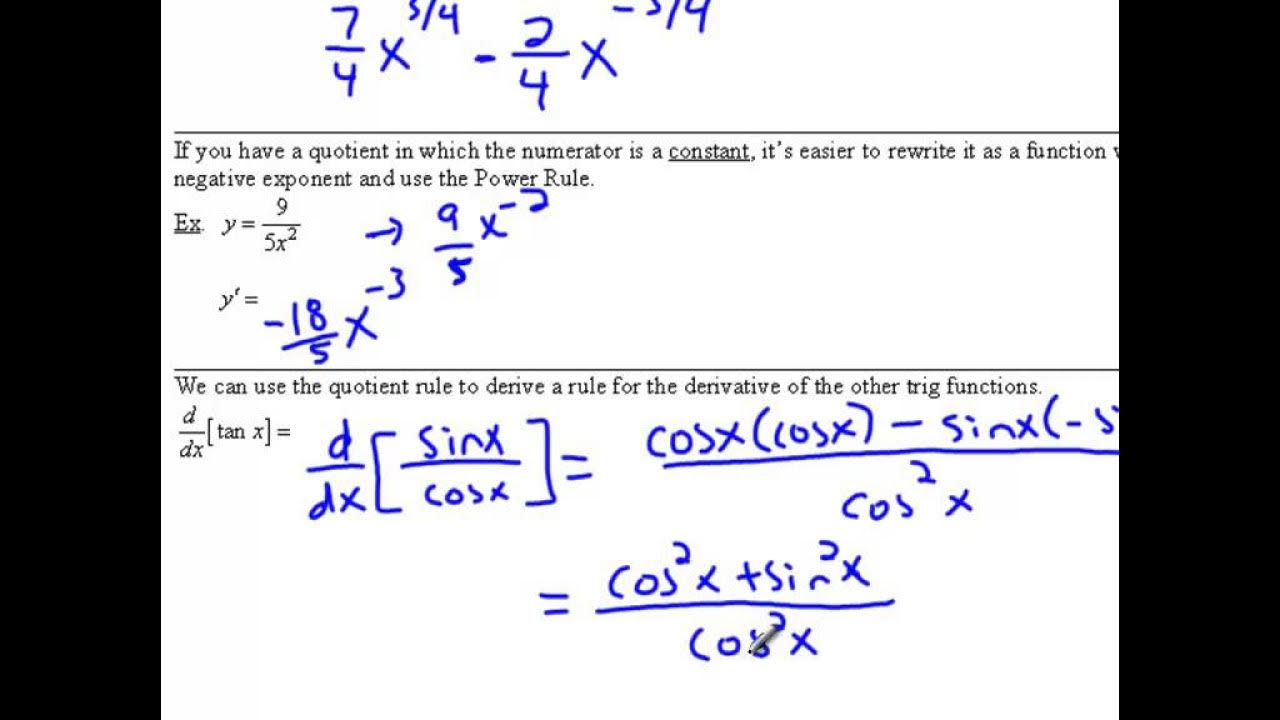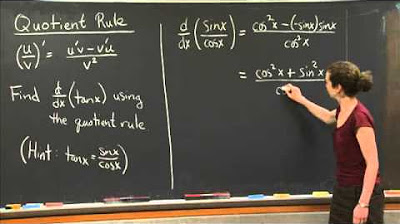The derivative of Trigonometric Functions
TLDRIn this video script, the presenter explores the derivatives of the sine and cosine functions without delving into formal geometric proofs. They use a graphical approach to illustrate that the derivative of sine (sin) is equal to cosine (cos) and vice versa, with the derivative of cosine being equal to negative sine. The presenter then applies the quotient rule to find the derivative of tangent (tan), which results in secant squared (sec^2). They emphasize the importance of the Pythagorean identity, cos^2(x) + sin^2(x) = 1, in simplifying trigonometric derivatives. The script also mentions that memorizing these derivatives is crucial for success in calculus due to their frequent use.
Takeaways
- 📈 The derivative of sine (sin(x)) is equal to cosine (cos(x)).
- 📉 The derivative of cosine (cos(x)) is equal to negative sine (-sin(x)).
- 🔶 The tangent function (tan(x)) is defined as sine over cosine (sin(x)/cos(x)).
- 🔵 The derivative of tangent (tan(x)) is calculated using the quotient rule and results in secant squared (sec^2(x)).
- 🔸 The Pythagorean identity cos^2(x) + sin^2(x) = 1 is crucial for deriving the derivatives of trigonometric functions.
- 📌 The derivative of cotangent (cot(x)) can be found by applying the quotient rule to cosine over sine (cos(x)/sin(x)).
- 📏 The derivative of secant (sec(x)) and cosecant (csc(x)) also follow from the quotient rule and the Pythagorean identity.
- 🧮 Memorizing the derivatives of trigonometric functions is essential as they are frequently used in calculus.
- 📚 The provided list of derivatives is lengthy, but understanding the derivatives of sine and cosine is the foundation for the rest.
- 📝 Practice and repetition are advised for memorizing the derivatives, as they will be used repeatedly in calculus problems.
- ➗ The derivative of a quotient of two functions is found using the quotient rule, which involves the derivatives of the numerator and denominator.
Q & A
What is the derivative of sine with respect to x?
-The derivative of sine with respect to x is cosine. This is based on the observation that the slope of the tangent line to the sine curve at x=0 matches the value of cosine at that point.
What is the derivative of cosine with respect to x?
-The derivative of cosine with respect to x is negative sine. This is inferred from the fact that as the slope of the tangent line to the cosine curve changes, the value of sine provides the corresponding negative rate of change.
How does the value of cosine at x=0 relate to the slope of the tangent line of sine at the same point?
-At x=0, the value of cosine is 1, and the slope of the tangent line to the sine curve is approximately 1, indicating they are the same at this point.
What is the slope of the tangent line to the sine curve at x = π/4?
-The slope of the tangent line to the sine curve at x = π/4 is less than 1, which corresponds to the value of cosine at π/4, which is 1/√2.
At what value of x is the derivative of sine equal to zero?
-The derivative of sine is equal to zero at x = π/2, which is the point where the sine curve is horizontal.
What is the relationship between the derivative of tangent and the quotient rule?
-The derivative of tangent (tan(x)) is found by applying the quotient rule to the expression sine(x)/cosine(x). The quotient rule states that the derivative of a quotient is the denominator times the derivative of the numerator minus the numerator times the derivative of the denominator, all divided by the square of the denominator.
What trigonometric identity is used to simplify the derivative of tangent?
-The Pythagorean identity, which states that cosine^2(x) + sine^2(x) = 1, is used to simplify the derivative of tangent to secant squared of x (sec^2(x)).
How can one find the derivative of cotangent using the quotient rule?
-Since cotangent is defined as cosine/sine, one can find its derivative by applying the quotient rule, considering the derivative of cosine as the negative sine and using the Pythagorean identity to simplify the expression.
What is the importance of memorizing the derivatives of trigonometric functions?
-The derivatives of trigonometric functions are used frequently in calculus, so memorizing them allows for quicker problem-solving and a deeper understanding of the subject.
Why does the script mention that only the sine and cosine derivatives need to be memorized?
-The derivatives of other trigonometric functions can be derived from the sine and cosine derivatives using the quotient rule and the definitions of the respective trigonometric functions.
What is the significance of the point x = π/2 in the context of the derivative of cosine?
-At x = π/2, the derivative of cosine is zero because the cosine curve has a horizontal tangent at this point, and the value of sine at π/2 is zero, which corresponds to the cosine's rate of change being zero.
Outlines
📈 Derivatives of Sine and Cosine Functions
The first paragraph of the video script discusses the derivatives of the sine and cosine functions without delving into formal geometric proofs. The speaker uses the tangent line at x=0 for the sine function to illustrate that the slope is approximately 1, which aligns with the value of cosine at 0. As the value of x increases, the slope of the tangent line to the sine function decreases, mirroring the decrease in the value of cosine. The speaker concludes that the derivative of sine is equal to cosine and the derivative of cosine is the negative of sine. This understanding is then used to derive the derivatives of other trigonometric functions such as tangent, cotangent, secant, and cosecant by applying the quotient rule and utilizing the Pythagorean identity.
📚 Memorization of Trigonometric Derivatives
The second paragraph emphasizes the importance of memorizing the derivatives of trigonometric functions, as they are frequently used in calculus. The speaker reassures that while the chart of derivatives may seem long and complicated initially, repeated use will lead to memorization. They highlight that knowing the derivatives of sine and cosine, along with the definitions of other functions like cotangent, is sufficient. The quotient rule can be applied to find the derivatives of these functions during an exam. The speaker encourages practice and repetition to internalize these mathematical relationships.
Mindmap
Keywords
💡Derivative
💡Cosine Function
💡Sine Function
💡Tangent Line
💡Quotient Rule
💡Tangent Function
💡Pythagorean Identity
💡Secant Function
💡Cotangent Function
💡Graph
💡Trigonometric Functions
Highlights
The speaker does not go through the formal geometric proof of trigonometric derivatives but aims to illustrate the reasoning behind them.
The derivative of sine at x=0 is approximately 1, matching the value of cosine at the same point.
As x increases, the slope of the tangent line to the sine function decreases, reflecting the decrease in the value of cosine.
The derivative of sine is 0 at x = π/2, where the cosine function also equals 0.
Beyond x = π/2, the slope of the sine function becomes negative, corresponding with the negative values of cosine.
The speaker proposes that the derivative of sine is equal to cosine, based on the observed relationship between their values.
The derivative of cosine is found to be the negative value of sine through a similar analysis.
The derivative of tangent (tan) is derived using the quotient rule and the relationship between sine and cosine.
The Pythagorean identity \( \cos^2(x) + \sin^2(x) = 1 \) is used to simplify the expression for the derivative of tangent.
The final expression for the derivative of tan is \( \sec^2(x) \), where secant is defined as \( 1/\cos(x) \).
The speaker suggests that memorizing the derivatives of trigonometric functions is essential due to their frequent use in calculus.
The derivative formulas for cotangent, secant, and cosecant can be derived using the quotient rule and the Pythagorean identity.
The full list of trigonometric derivatives is provided, which is considered lengthy and complex but necessary to memorize for frequent use.
The importance of practice and repetition in memorizing the derivative formulas is emphasized.
The speaker provides a method to derive the derivative of cosine at x=0, which is horizontal and equals zero.
The value of cosine at π/4 is used to illustrate the change in slope of the tangent line to the sine function.
The concept of the derivative as a measure of the rate of change is applied to understand the behavior of the sine and cosine functions.
The process of deriving the derivative of tangent is explained step by step, emphasizing the use of the quotient rule.
Transcripts
Browse More Related Video
5.0 / 5 (0 votes)
Thanks for rating:





